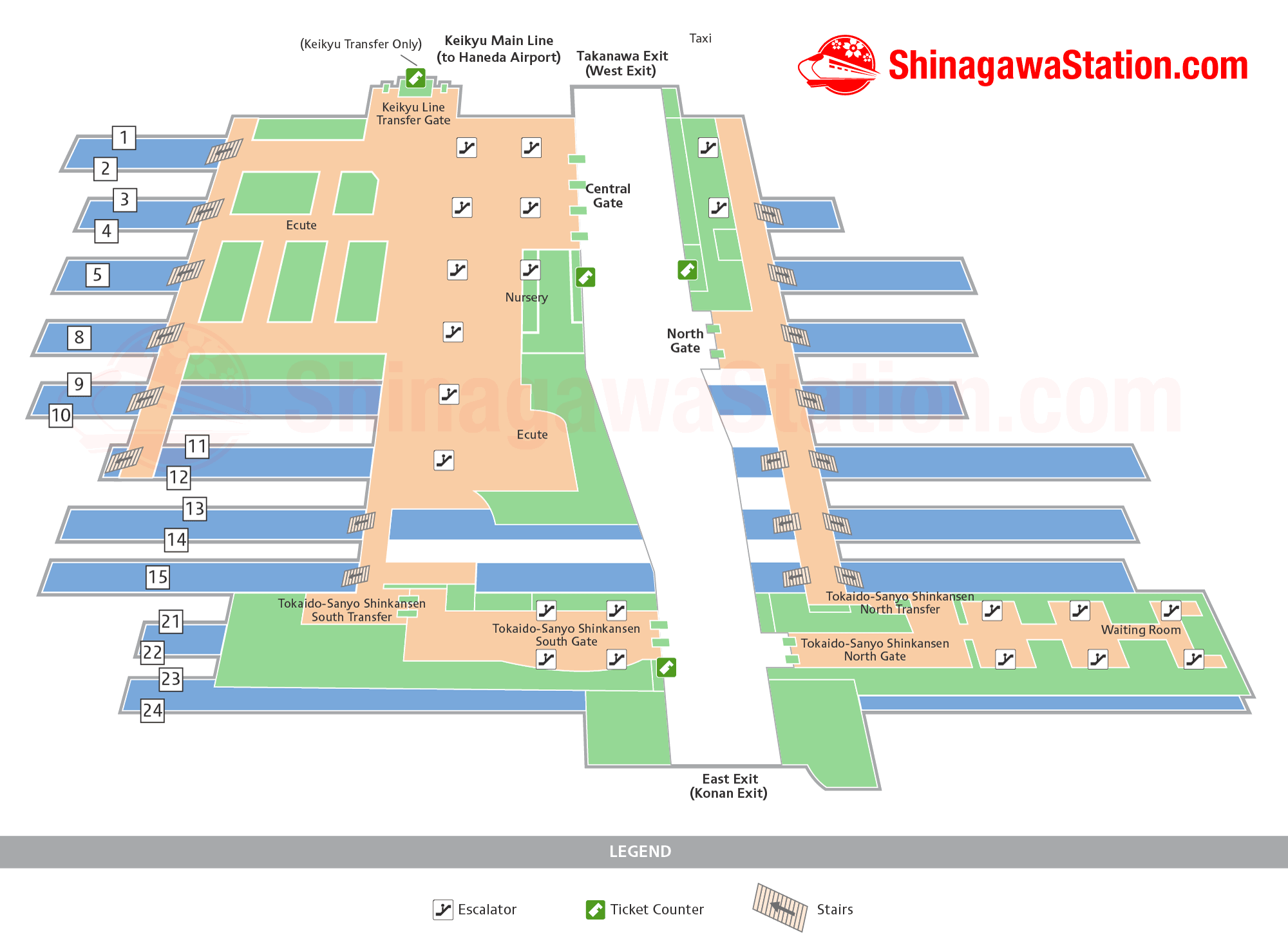The capital’s latest emerging rail hub is Shinagawa Station, located in the south end of central Tokyo. Ever since Tokaido Shinkansen bullet train services began at Shinagawa in October 2003, followed by the addition of the Ueno-Tokyo commuter line in 2015, Shinagawa has become increasingly important for travelers as well as commuters.
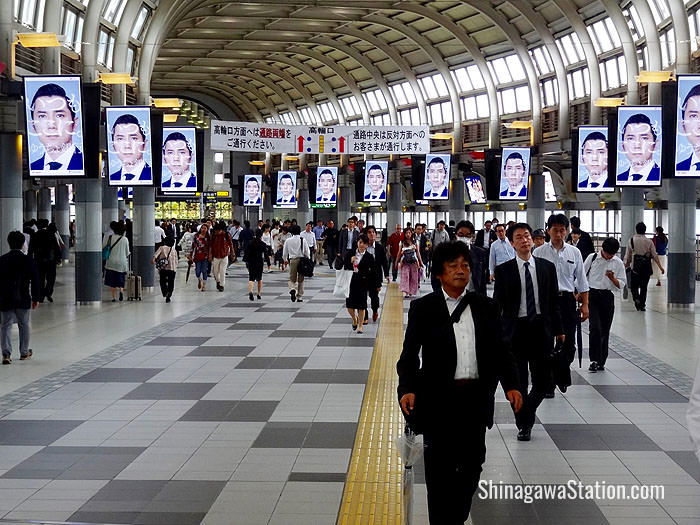
The central passageway at JR Shinagawa Station
In terms of rail services, Shinagawa is hard to beat. It has bullet trains heading to Nagoya, Kyoto and Osaka, links to Haneda and Narita airports, a stop on the JR Yamanote loop line, and trains that go to the popular Asakusa temple district via the Tokyo subway.
Table of Contents
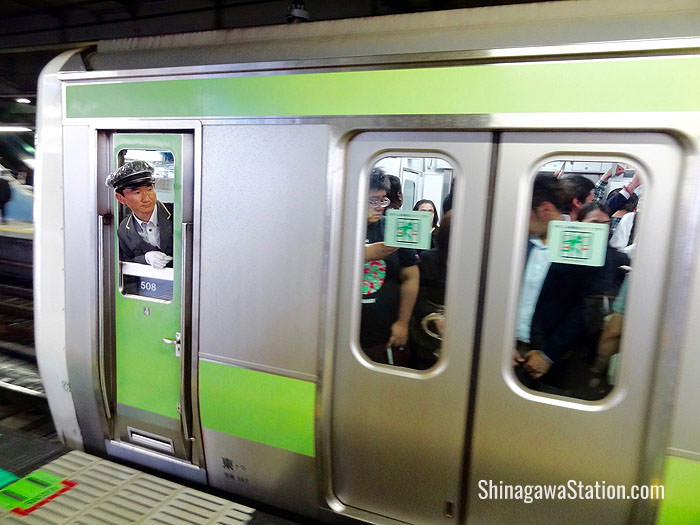
A Yamanote loop line train stops at JR Shinagawa Station
Shinagawa Station is also refreshingly easy to navigate compared to other rail complexes in Tokyo. Its only drawback is that the surrounding district is given over to offices and hotels, and has few attractions for travelers apart from Sengakuji temple, famed for its association with the famous 47 ronin (masterless samurai) who died in 1703 after avenging their lord.
This article will familiarize you with the layout of Shinagawa Station and its train lines and platforms. For information about non-rail services here, see our Shinagawa Building Facilities article.
General Orientation
Shinagawa Station is about 6.3 km south of Tokyo Station and some 10 km north of Haneda Airport, making it a convenient stop for overseas travelers. The main station consists of a large complex run by East Japan Railway (JR East) straddling a number of north-south railways including the JR Yamanote Line, which circles the heart of Tokyo. A broad east-west passageway runs through the center of the complex and joins the two main entrances.
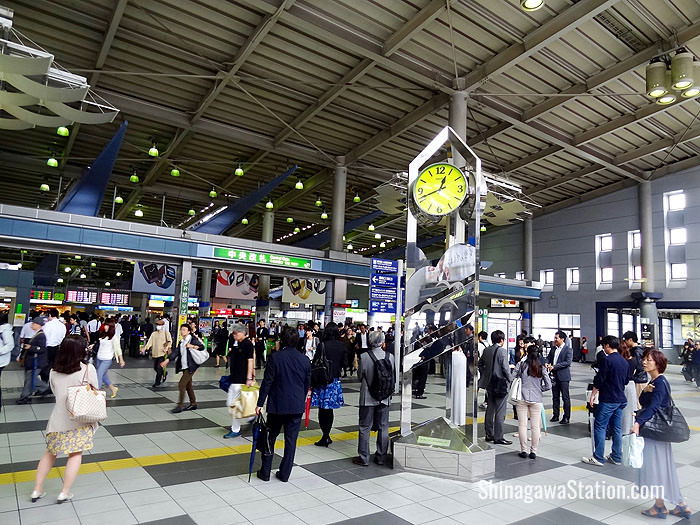
A clock stands in the central passageway near the Central Gate
The main entrances are on the west and east sides, with gates inside the building. The Tokaido-Sanyo Shinkansen bullet train tracks are on the east side (Konan side) of the complex, and are separated from the other JR railways by their own gates.

A signboard by the Central Gate at JR Shinagawa Station points the way
The other JR railways (including Narita Express services) are in the middle of the station, and the Keikyu Main Line for Haneda airport, Narita Airport and Asakusa are on the west side (Takanawa side) in a separate complex with an interior transfer gate to the JR building.
The west or Takanawa side of the station is home to hotels including the Shinagawa Prince as well as several shopping malls and a large taxi bay. The east or Konan side hosts the Atre Shinagawa mall, The Strings Tokyo Hotel and a number of corporate headquarters including Sony.
Shinagawa Station Main Gates and Exits
As mentioned above, JR Shinagawa Station has two main entrances (west or Takanawa side and the east or Konan side) There are two main gates inside JR Shinagawa Station, both in the central passageway – the Central Gate, which is closer to the west side, and the North Gate, which is a bit closer to the east side.
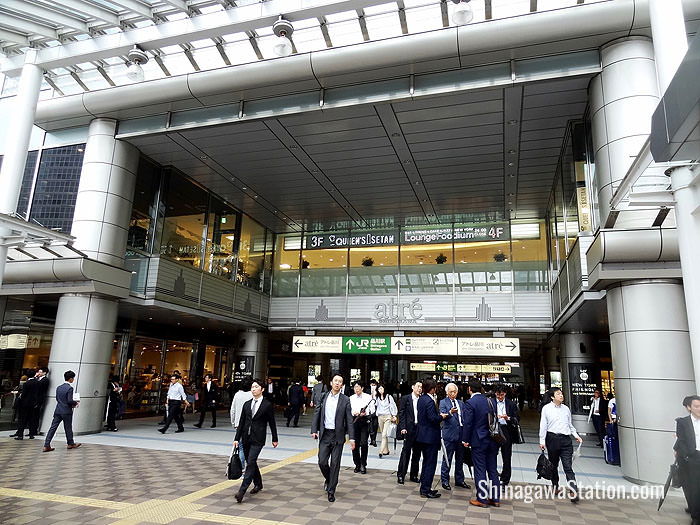
The Konan or east entrance at JR Shinagawa Station
The Tokaido Shinkansen bullet train line has north and south gates on the central passageway by the east side of the station. Inside the bullet train station are south and north transfer gates to the other JR lines.
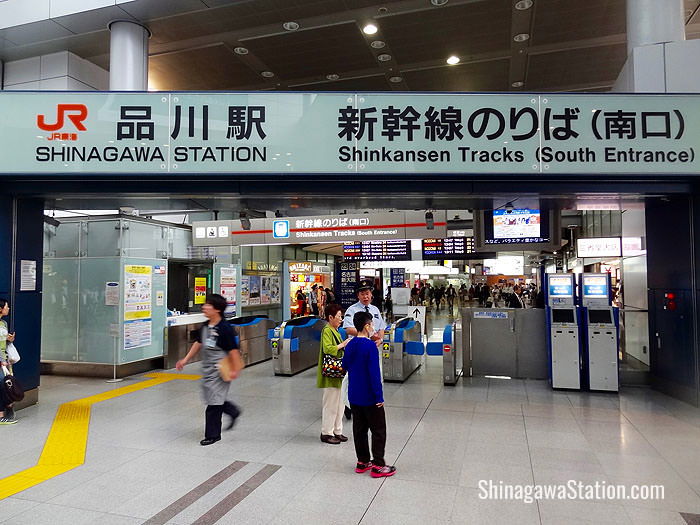
The south gate to the Shinkansen tracks at JR Shinagawa Station
While there is an interior transfer gate to JR lines, Keikyu Shinagawa Station has a main exterior entrance and gate on the west or Takanawa side near the entrance to the JR complex.
Keikyu Line Transfer Gate
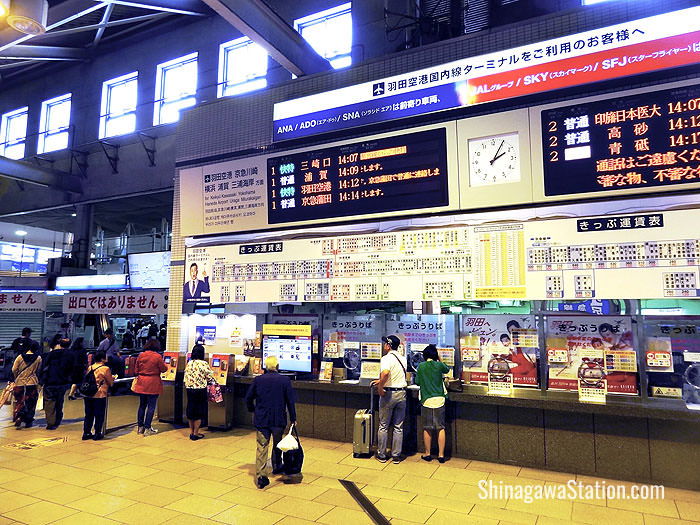
Ticket sales booths at the Keikyu Line Transfer Gate on the JR side of Shinagawa Station
Inside the JR Shinagawa Station complex and on the west side within the Central Gate area, you’ll find the Keikyu Line Transfer Gate. This is a line of ticket gates, ticket vending machines and ticket sales booths for the Keikyu Main Line. Unless you have a Suica or Pasmo prepaid transportation card, you’ll need a separate ticket to ride Keikyu railways.
JR Train Line Platforms
There are about 20 train platforms at JR Shinagawa Station, though some are not in use. Each is color-coded. Note that the Tokaido Main Line, which connects Tokyo with cities to the southwest, differs from the Tokaido Shinkansen bullet train.

A Narita Express limited express service stops at JR Shinagawa Station
Platform 1: Yamanote Line bound for Tokyo and Ueno
Platform 2: Yamanote Line bound for Shibuya, Shinjuku and Ikebukuro
Platform 3: Keihin-Tohoku Line bound for Tokyo, Ueno and Omiya
Platform 4: Keihin-Tohoku Line bound for Kawasaki, Yokohama and Ofuna
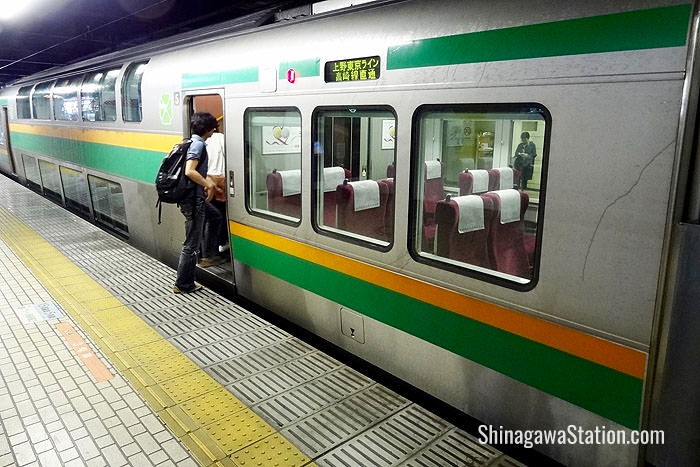
A Ueno-Tokyo Line train with a double-decker Green Car compartment stops at JR Shinagawa Station
Platforms 5 & 8: Tokaido Main Line bound for Tokyo, Ueno, Omiya, Utsunomiya and Takasaki
Platform 9: Ueno-Tokyo Line bound for Tokyo, Ueno; Joban Line bound for Mito and Iwaki
Platform 10: Ueno-Tokyo Line, Joban Line Rapid bound for Toride and Mito
Platform 11: Tokaido Main Line bound for Kawasaki, Odawara, Atami, Izukyu-Shimoda, Shuzenji; Ueno-Tokyo, Joban Line Rapid bound for Tokyo, Ueno, Toride, Mito and Narita
Platform 12: Tokaido Main Line bound for Kawasaki, Odawara, Atami, Izukyu-Shimoda and Shuzenji
Platforms 13 & 14: Yokosuka Line, Sobu Line bound for Tokyo, Chiba; Narita Express bound for Narita Airport
Platform 15: Yokosuka Line bound for Kamakura, Zushi and Kurihama; Narita Express bound for Tokyo, Shinagawa and Ofuna
Tokaido Shinkansen Bullet Train Platforms
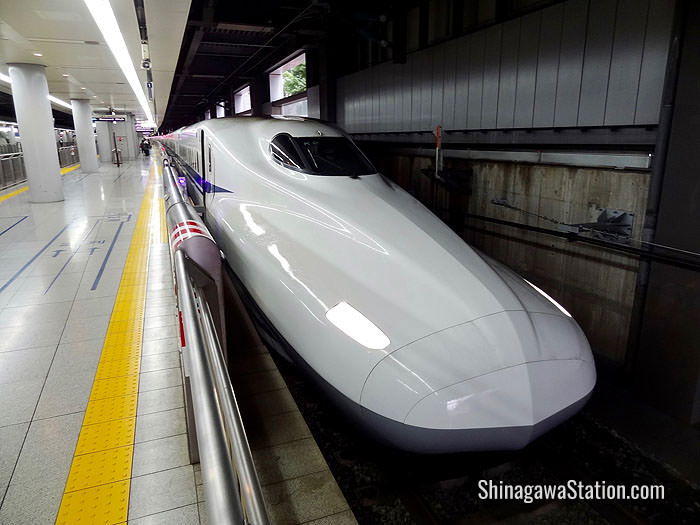
A Tokaido bullet train bound for Shin-Osaka stops at Shinagawa Station
Platforms 21 & 22: Tokaido Shinkansen bullet trains bound for Tokyo
Platforms 23 & 24: Tokaido Shinkansen bullet trains bound for Nagoya, Kyoto and Shin-Osaka
Keikyu Main Line Platforms
Platform 1: Keikyu Main Line bound for Haneda Airport, Yokohama and Miura-Kaigan
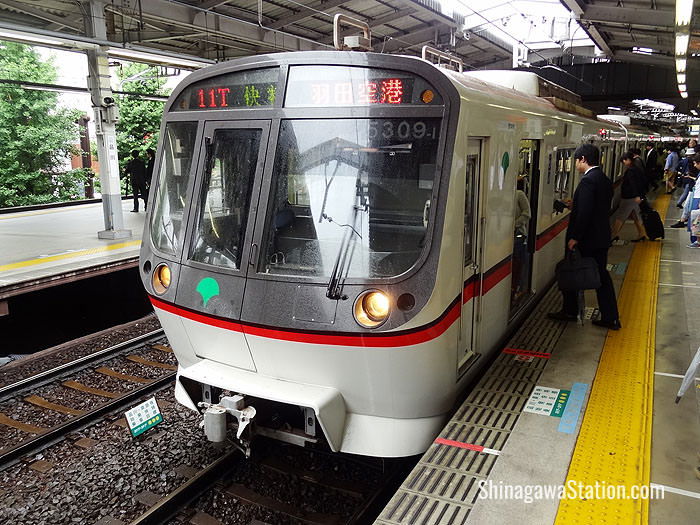
A Keikyu Main Line special service for Haneda Airport stops at Keikyu Shinagawa Station
Platform 2: Keikyu Main Line bound for Shimbashi, Nihombashi and Narita Airport
Platform 3: Keikyu Main Line bound for Yokohama and Yokosuka-Chuo
Article by Tim Hornyak. All rights reserved.
